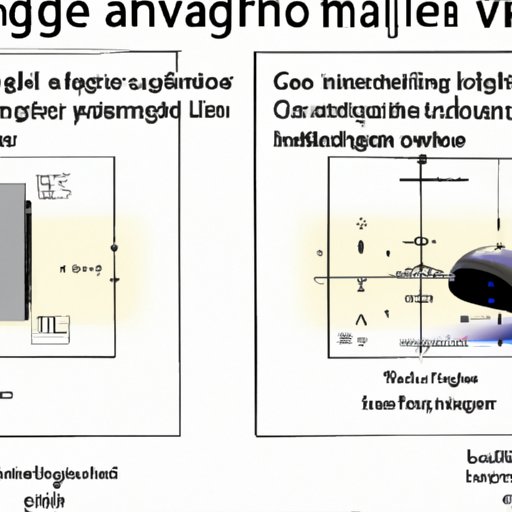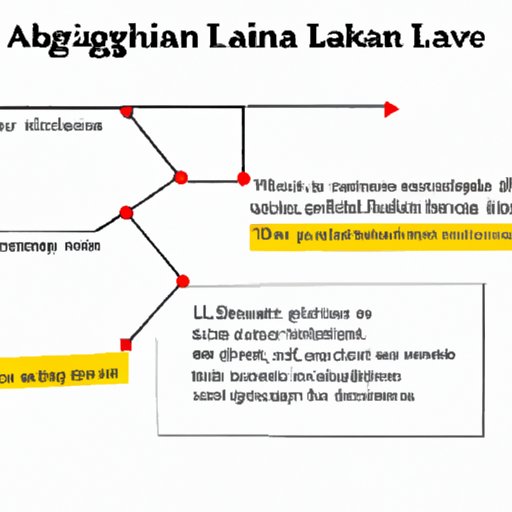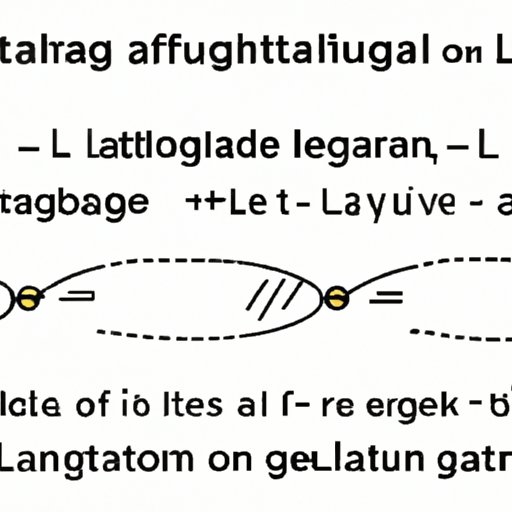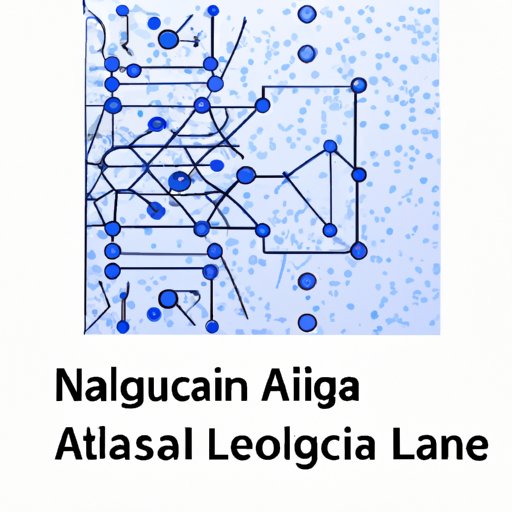Introduction
Linear algebra is a branch of mathematics that deals with vectors, matrices, and linear equations. It is a fundamental tool for many areas of computer science, and it is used to solve problems ranging from basic calculations to complex machine learning algorithms. In this article, we will explore how linear algebra is used in computer science and discuss some of the ways it is applied in data science, image processing, machine learning, network analysis, natural language processing, and artificial intelligence.
Exploring the Role of Linear Algebra in Data Science
Data science is the process of analyzing data to uncover patterns, trends, and insights. Linear algebra plays an important role in data science by providing powerful tools for manipulating data and solving complex problems. Here, we will look at some of the basics of linear algebra and how it is applied to data analysis.
Linear Algebra Basics
At the most basic level, linear algebra is used to represent and manipulate mathematical objects, such as vectors, matrices, and linear equations. Vectors are collections of numbers, and matrices are collections of vectors. Linear equations describe relationships between variables, and can be used to model real-world phenomena. Linear algebra provides powerful tools for representing and manipulating these mathematical objects, which can then be used to solve complex problems.
Linear Algebra in Data Analysis
Linear algebra is used extensively in data analysis. It can be used to identify patterns in data and build models that can be used to make predictions. It can also be used to optimize parameters and find the best solutions to complex problems. For example, linear algebra can be used to identify correlations between variables, build predictive models, and optimize parameters in machine learning algorithms.
Examples of Linear Algebra in Data Science
Linear algebra is used in a wide range of data science applications, including data visualization, forecasting, optimization, and more. Here are some examples of how linear algebra is used in data science:
- Matrices can be used to represent data and calculate correlations between variables.
- Vector calculus can be used to optimize parameters for machine learning algorithms.
- Linear equations can be used to create predictive models from data.
- Matrix factorization can be used to uncover hidden features in data.

Applying Linear Algebra to Image Processing and Computer Vision
Image processing and computer vision involve using computers to analyze images and extract useful information. Linear algebra is used extensively in both fields, as it provides powerful tools for manipulating images and extracting meaningful information. Here, we will look at how linear algebra is used for image processing and computer vision.
Using Linear Algebra for Image Processing
Linear algebra is used extensively in image processing. It can be used to represent images as matrices, apply transformations to images, and perform various operations on images. For example, linear algebra can be used to rotate, scale, or crop images, as well as to blur, sharpen, or apply other filters to them.
Working with Images in Linear Algebra
In linear algebra, images are represented as matrices of numbers. Each number in the matrix represents the intensity of a pixel in the image. This allows us to use linear algebra to manipulate images. We can use linear algebra to apply transformations to images, such as scaling, rotating, or cropping them. We can also use linear algebra to apply effects to images, such as blurring, sharpening, or applying other filters.
Examples of Linear Algebra in Computer Vision
Linear algebra is used extensively in computer vision. Here are some examples of how linear algebra is used in computer vision:
- Linear algebra can be used to represent images as matrices of numbers.
- Matrices can be used to apply transformations to images, such as scaling, rotating, or cropping them.
- Linear algebra can be used to detect edges in images.
- Linear algebra can be used to classify objects in images.
- Linear algebra can be used to track objects in videos.

Using Linear Algebra to Design Algorithms for Machine Learning
Machine learning is the process of using algorithms to learn from data. Linear algebra is used extensively in machine learning, as it provides powerful tools for designing algorithms that can learn from data. Here, we will look at how linear algebra is used to design algorithms for machine learning.
What is Machine Learning?
Machine learning is a type of artificial intelligence that uses algorithms to learn from data. These algorithms take input data and use it to “learn” patterns and make predictions. Machine learning algorithms can be used for a variety of applications, such as predicting stock prices, recognizing objects in images, and diagnosing diseases.
Designing Algorithms with Linear Algebra
Linear algebra is used extensively in the design of machine learning algorithms. It provides powerful tools for manipulating data and building models that can be used to make predictions. For example, linear algebra can be used to identify patterns in data and build predictive models. It can also be used to optimize parameters for machine learning algorithms, such as neural networks.
Examples of Linear Algebra in Machine Learning
Linear algebra is used in a wide range of machine learning applications, including classification, clustering, regression, and more. Here are some examples of how linear algebra is used in machine learning:
- Matrices can be used to represent data and calculate correlations between variables.
- Vector calculus can be used to optimize parameters for machine learning algorithms.
- Linear equations can be used to create predictive models from data.
- Matrix factorization can be used to uncover hidden features in data.
Analyzing Network Structures with Linear Algebra
Network analysis is the process of studying the structure of networks. Networks can be used to represent complex systems, such as social networks and computer networks. Linear algebra is used extensively in network analysis, as it provides powerful tools for understanding and analyzing network structures. Here, we will look at how linear algebra is used for network analysis.
Understanding Networks
A network is a collection of nodes and edges. Nodes represent entities, such as people or computers, and edges represent relationships between them. Networks can be used to represent complex systems, such as social networks, computer networks, and biological networks.
Representing Networks with Linear Algebra
Linear algebra is used extensively in network analysis. It can be used to represent networks as matrices and vectors, and to calculate properties of networks, such as centrality and connectivity. For example, linear algebra can be used to calculate the shortest path between two nodes in a network, or to identify clusters of nodes in a network.
Examples of Linear Algebra in Network Analysis
Linear algebra is used in a wide range of network analysis applications, including link prediction, community detection, and more. Here are some examples of how linear algebra is used in network analysis:
- Matrices can be used to represent networks and calculate properties, such as centrality and connectivity.
- Vector calculus can be used to calculate the shortest path between two nodes in a network.
- Linear equations can be used to identify clusters of nodes in a network.
- Matrix factorization can be used to uncover hidden features in networks.

Utilizing Linear Algebra for Natural Language Processing
Natural language processing (NLP) is the process of using computers to understand and generate natural language. Linear algebra is used extensively in NLP, as it provides powerful tools for analyzing and generating text. Here, we will look at how linear algebra is used for NLP.
What is Natural Language Processing?
Natural language processing (NLP) is the process of using computers to understand and generate natural language. NLP algorithms can be used for a variety of applications, such as automated question answering, sentiment analysis, machine translation, and more.
Using Linear Algebra for NLP
Linear algebra is used extensively in NLP. It can be used to represent words and documents as vectors, and to calculate similarities between them. For example, linear algebra can be used to calculate the similarity between two sentences, or to identify related words in a document.
Examples of Linear Algebra in NLP
Linear algebra is used in a wide range of NLP applications, including text classification, text generation, and more. Here are some examples of how linear algebra is used in NLP:
- Vectors can be used to represent words and documents.
- Matrices can be used to calculate similarities between words and documents.
- Linear equations can be used to generate text based on existing data.
- Matrix factorization can be used to uncover hidden topics in text.
Linear Algebra’s Impact on Artificial Intelligence
Artificial intelligence (AI) is the process of using computers to simulate human intelligence. Linear algebra is used extensively in AI, as it provides powerful tools for designing algorithms that can learn from data. Here, we will look at how linear algebra is used for AI.
What is Artificial Intelligence?
Artificial intelligence (AI) is the process of using computers to simulate human intelligence. AI algorithms can be used for a variety of applications, such as playing games, controlling robots, and making decisions based on data.
Leveraging Linear Algebra for AI
Linear algebra is used extensively in AI. It can be used to represent data and build models that can be used to make predictions. For example, linear algebra can be used to identify patterns in data and build predictive models. It can also be used to optimize parameters for AI algorithms, such as neural networks.
Examples of Linear Algebra in AI
Linear algebra is used in a wide range of AI applications, including classification, clustering, regression, and more. Here are some examples of how linear algebra is used in AI:
- Matrices can be used to represent data and calculate correlations between variables.
- Vector calculus can be used to optimize parameters for AI algorithms.
- Linear equations can be used to create predictive models from data.
- Matrix factorization can be used to uncover hidden features in data.
Conclusion
In conclusion, linear algebra is a powerful tool for many areas of computer science. It is used extensively in data science, image processing, machine learning, network analysis, natural language processing, and artificial intelligence. Linear algebra provides powerful tools for manipulating data and building models that can be used to make predictions. By leveraging the power of linear algebra, we can solve complex problems and unlock new insights from data.
(Note: Is this article not meeting your expectations? Do you have knowledge or insights to share? Unlock new opportunities and expand your reach by joining our authors team. Click Registration to join us and share your expertise with our readers.)
